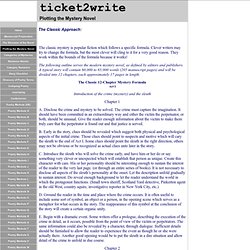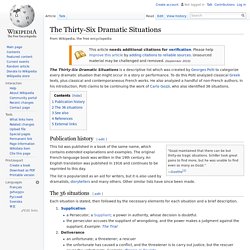

Tobias' 20 Plots. Disciplines > Storytelling > Plots > Tobias' 20 Plots The 20 Plots | See also Ronald Tobias, in his popular and practical book, 20 Master Plots, and how to build them, describes 20 common story plots and gives lots of detail on how to construct complete stories around them.

Create A Plot Outline In 8 Easy Steps. By Glen C.

Strathy How would you like to create a plot outline for your novel in less than an hour that is emotionally compelling and dramatically sound? It's easier than you think. The secret is to incorporate the 8 Basic Plot Elements. Starting with your story idea, you only need to make eight choices to ensure the plot of your future novel hangs together in a meaningful way. Sound intriguing?
8 simple formula plot templates « The wise sloth says, The story begins by introducing the protagonist in a way that reveals his defining characteristics, strengths, weaknesses, life circumstances, motives, and goals.

How to Use Index Cards to Write a Novel Outline. Damn it Neil, the name is Nuwanda. Write a Plot Outline: Infographic. Beat Sheet: Pride and Prejudice. Chick 1 says: I thought for our second beat sheet we’d look at a story as far from Hot Fuzz as possible.

So I chose Pride and Prejudice, the 2005 version starring Keira Knightley and Matthew Macfadyen and directed by Joe Wright. How will a movie that’s based on a 200-year-old novel line up against our list of beats? I admit it was more difficult to pick out the beats in this than Hot Fuzz and sometimes I’m not completely sure they were there at all. Tell me what you think of the scenes I’ve picked out. Opening Image – A visual that represents the struggle & tone of the story. Story Structure Thriller. Plotting the Mystery Novel. The classic mystery is popular fiction which follows a specific formula.

Clever writers may try to change the formula, but the most clever will cling to it for a very good reason. They work within the bounds of the formula because it works! The following outline serves the modern mystery novel, as defined by editors and publishers. A typical story will contain 60,000 to 65,000 words (205 manuscript pages) and will be divided into 12 chapters, each approximately 17 pages in length.
The Classic 12-Chapter Mystery Formula Act I. Writing the Cozy Mystery. By Stephen D.

Rogers A cozy is a mystery which includes a bloodless crime and generally contains very little violence, sex, or coarse language. By the end of the story, the criminal is punished and order is restored to the community. The character solving the crime is often an amateur sleuth who becomes involved because of personal reasons but it is also possible for the character to be a professional: police officer, medical examiner, or private detective. Many cozies invite the reader to solve the crime first. The novels of Agatha Christie and the mystery stories in Woman's World are examples of cozies.
Cozy Characters The main character in a cozy is the good guy (or gal). Writing. 3 Types of Character Arcs: Choose the Best for Your Novel. Samurai cinema. While earlier samurai period pieces were more dramatic rather than action-based, samurai movies post World War II have become more action-based, with darker and more violent characters.

Post-war samurai epics tended to portray psychologically or physically scarred warriors.[2] Akira Kurosawa stylized and exaggerated death and violence in samurai epics. His samurai, and many others portrayed in film, were solitary figures, more often concerned with concealing their martial abilities, rather than bragging of them.[2] Historically, the genre is usually set during the Tokugawa era (1600–1868), the samurai film focuses on the end of an entire way of life for the samurai, many of the films deal with masterless ronin, or samurai dealing with changes to their status resulting from a changing society. Samurai film directors[edit] Kihachi Okamoto films focus on violence in a particular fashion.
Jordan McCollum: Six Steps to Stronger Character Arcs in Romances. I’m excited to welcome back JORDAN MCCOLLUM.

Today Jordan tackles the tricky topic of character arcs – with a checklist to help make them stronger. You can have the greatest plot in the world—but if your characters are flat your book will be, too. For a character to truly resonate with readers, s/he should change and grow over the course of the story. For more powerful characters, focus not just on the external plot, but the characters’ internal journey as well. Relationship stories—romances, family dramas, “bromances,” buddy flicks, even sports movies—are all about building a relationship based on love (platonic, familial, romantic). The essential principles start with ideas on character growth from screen writer Michael Hauge.
Second, each character needs some sort of “wound” in their backstory, some sort of bad experience in the past that has left them still hurting in the present. How To Write A Novel Using The Snowflake Method. Write a Plot Outline: Infographic. 50 Romance Plot Ideas! This post was originally titled, “Master List of Romantic Conflicts,” but it really contains big ideas for entire plots.

A Writer’s Cheatsheet to Plot and Structure. How to Structure A Story: The Eight-Point Arc. By Ali Hale - 3 minute read One of my favourite “how to write” books is Nigel Watts’ Writing A Novel and Getting Published. A Writer’s Cheatsheet to Plot and Structure. The Thirty-Six Dramatic Situations. The Thirty-Six Dramatic Situations is a descriptive list which was created by Georges Polti to categorize every dramatic situation that might occur in a story or performance.

To do this Polti analyzed classical Greek texts, plus classical and contemporaneous French works. He also analyzed a handful of non-French authors. In his introduction, Polti claims to be continuing the work of Carlo Gozzi, who also identified 36 situations. Publication history[edit] Elements of Suspense in Writing: 6 Secret to Creating and Sustaining Suspense. Thriller writing? Mystery writing? Literary fiction? It’s all the same: Building apprehension in the minds of your readers is one of the most effective keys to engaging them early in your novel and keeping them flipping pages late into the night.
Simply put, if you don’t hook your readers, they won’t get into the story. If you don’t drive the story forward by making readers worry about your main character, they won’t have a reason to keep reading. Think: Worry equals suspense. Monomyth. Joseph Campbell's monomyth, or the hero's journey, is a basic pattern that its proponents argue is found in many narratives from around the world. This widely distributed pattern was described by Campbell in The Hero with a Thousand Faces (1949).[1] Campbell, an enthusiast of novelist James Joyce, borrowed the term monomyth from Joyce's Finnegans Wake.[2] Campbell held that numerous myths from disparate times and regions share fundamental structures and stages, which he summarized in The Hero with a Thousand Faces: A hero ventures forth from the world of common day into a region of supernatural wonder: fabulous forces are there encountered and a decisive victory is won: the hero comes back from this mysterious adventure with the power to bestow boons on his fellow man.[3] A chart outlining the Hero's Journey.
Summary[edit] How to Write a Book in Three Days: Lessons from Michael Moorcock. This article is the first part of a series about one of my favorite writers, Michael Moorcock, which will culminate in an interview with the man himself. In the early days of Michael Moorcock's 50-plus-years career, when he was living paycheck-to-paycheck, he wrote a whole slew of action-adventure sword-and-sorcery novels very, very quickly, including his most famous books about the tortured anti-hero Elric. In 1992, he published a collection of interviews conducted by Colin Greenland called Michael Moorcock: Death is No Obstacle, in which he discusses his writing method.